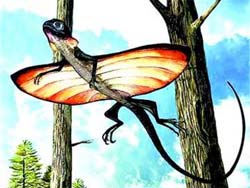
Although the outlandish reptiles and man-eating beasts in science-fiction movies are often scaring to some audience while fascinating to others, they are by no means merely the fancy of Hollywood screenwriters. For example, you may know that the flying lizard Draco in a number of Disney cartoons is extant and now living in the tropical areas of Southeast Asia. New archeological evidence has surfaced to convince us the occurrence of a similar creature some 130 million years ago in the early Cretaceous period, when the Earth was ruled by dinosaurs.
A fossil of gliding lizard was reported by a group of Chinese scientists from the Shenyang Normal University, Peking University and the CAS Institute of Vertebrate Paleontology and Paleoanthropology (IVPP). Collected in the west of Liaoning Province, or "Liaoxi," a treasure-trove of paleontology since recent years, it is the only species among extinct lizards capable of gliding along their 200 million years of evolvement.
The well-preserved specimen measures about 6 inches (155mm) in length with clear skin impressions. The skeleton features eight elongated dorsal ribs at both sides, which are probably covered with a leathery membrane called "patagium" to span 11.4 cm across at full expansion and enable the little animal to glide for insect prey. Once airborne, the lizard could probably fly as far as half a soccer field at a time, said Prof. XU Xing from IVPP and a member of the research team.
Most gliding animals, such as "flying" frogs and squirrels, employ a membrane spreading between their toes or between their body and legs to stay airborne, but without inner bony support. However, the newly unearthed creature demonstrates a more complicated and advanced way of travel which may very well have been the prototype for the modern avian wing.
Sankar Chatterjee, a paleontologist at Texas University in Lubbock, U.S., said the discovery was of high significance as "the first fossil evidence that unequivocally demonstrates an impression of the skin around the edge of the rib cage."
The researchers also told from the traits of curved claws and immature features that the lizard might be treetop-dwelling and died at a young age.
As another masterpiece contributed by China to world paleontology studies, the lizard was named
Xianglong Zhaoi (Zhao's flying dragon) to acknowledge Prof. Zhao Dayu, one of the forerunners of Liaoning Paleontological Museum and now President of Liaoning Normal University.
The report, coauthored by Li Pipeng, Gao Keqin, Hou Lianhai and Xu Xing, was published on the website of
the Proceedings of the National Academy of Sciences (PNAS) on 22 March and will come out in the print edition of 29 March. Considering the importance of this study, PNAS also released a special presentation on the paper as part of its weekly news.
Interestingly, some ancient lizard-like reptiles called Coelurosaurovus, Icarosaurus and Kuehneosaurus also had the similar rib-supported wings. They were found in Germany, North America and the U.K. respectively, and belonged to the Permian and Triassic periods, about 200 to 300 million years ago.
Therefore, connect all the facts and you will find the discovery is somewhat filling the gap in the evolutional history of the gliding lizards. "It is really amazing to see the evolvement making nearly identical structures in animals of different origins spanning such a long history." Prof. Xu was quoted as saying.
To paleontologists, it is also a surprising case of convergent revolution, which means animals of different origins develop similar organs to adapt to similar environment. In other words, Liaoxi might have been an area with flourishing rain forests and tropical/subtropical climate back to the early Cretaceous.
The researchers are going to uncover more information and understand the evolution process with the help of molecular biology.





